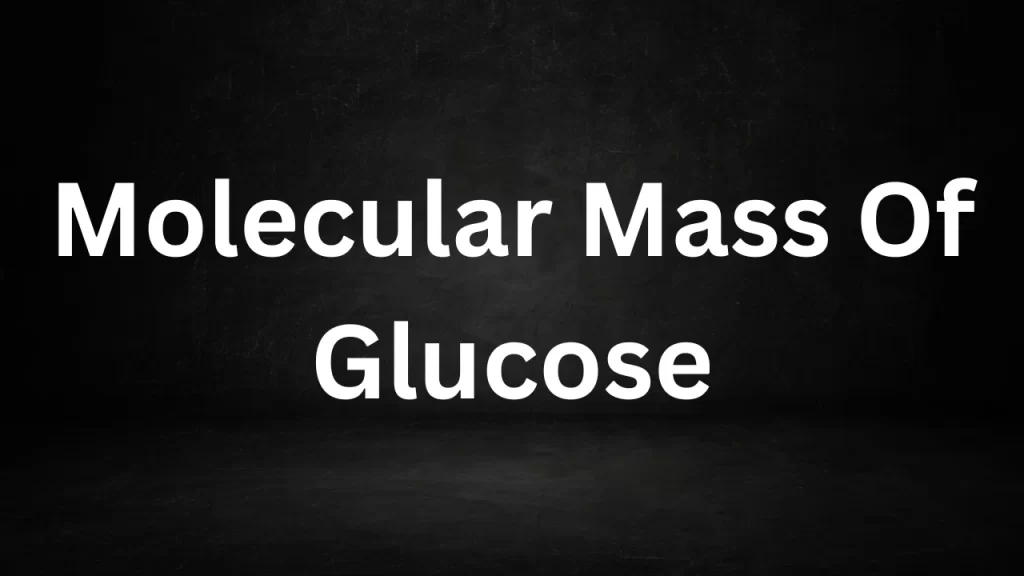Molecular Mass Of Glucose: Glucose, often referred to as the “fuel” of life, is a fundamental molecule in biology and biochemistry.
Its molecular mass plays a pivotal role in various scientific and practical applications, ranging from nutrition and energy metabolism to pharmaceuticals and clinical diagnostics. In this article, we delve into the molecular mass of C6H12O6, its significance, and its diverse applications.

Molecular Mass Of Glucose
Molecular Formula of Glucose
Before we explore the molecular mass of C6H12O6, it’s essential to understand its molecular formula. Glucose has the chemical formula C6H12O6. This formula represents the number of carbon (C), hydrogen (H), and oxygen (O) atoms in a single glucose molecule.
Calculating Molecular Mass
The molecular mass of a compound is the sum of the atomic masses of all the constituent atoms in its molecular formula. To calculate the molecular mass of C6H12O6, we add the atomic masses of the individual elements:
- Carbon (C) has an atomic mass of approximately 12.01 atomic mass units (amu).
- Hydrogen (H) has an atomic mass of approximately 1.01 amu.
- Oxygen (O) has an atomic mass of approximately 16.00 amu.
Now, let’s calculate the molecular mass of C6H12O6:
Molecular mass of glucose = (6 × C) + (12 × H) + (6 × O) Molecular mass of C6H12O6 ≈ (6 × 12.01 amu) + (12 × 1.01 amu) + (6 × 16.00 amu) Molecular mass of glucose ≈ 72.06 amu + 12.12 amu + 96.00 amu Molecular mass of glucose ≈ 180.18 amu
Rounded to two decimal places, the molecular mass of C6H12O6 is approximately 180.18 amu or 180.18 g/mol (grams per mole).
Significance of Molecular Mass
The molecular mass of glucose holds immense significance in various fields:
1. Nutrition: Glucose is a primary source of energy for the human body. Its molecular mass is used to calculate the calorie content in foods and beverages, providing vital nutritional information.
2. Biochemistry: In cellular metabolism, glucose undergoes glycolysis and other biochemical processes. Understanding its molecular mass is crucial for studying these metabolic pathways.
3. Pharmaceutical and Medical Applications: Glucose serves as a key component in various medications, intravenous solutions, and diagnostic tests. Knowledge of its molecular mass is essential for formulation and dosage calculations.
4. Chemical Reactions: In chemistry, the molecular mass of glucose is used in stoichiometric calculations, chemical reactions, and the determination of molar concentrations in solutions.
5. Industrial Processes: Glucose is utilized in the food industry for sweetening and in fermentation processes for biofuel and alcohol production. Its molecular mass is relevant in industrial calculations.
Glucose in the Human Body
In the human body, glucose is transported through the bloodstream and taken up by cells. It is a primary substrate for cellular respiration, where it is oxidized to produce adenosine triphosphate (ATP), the energy currency of cells. Proper regulation of blood glucose levels is essential for maintaining health.
Conclusion
The molecular mass of glucose, approximately 180.18 g/mol, is a fundamental parameter in nutrition, biochemistry, pharmaceuticals, and numerous scientific disciplines. It underscores the essential role glucose plays as an energy source and its widespread applications in various industries.
Understanding the molecular mass of glucose allows scientists, healthcare professionals, and researchers to make precise calculations and advances in their respective fields, ultimately contributing to our knowledge of life processes and the practical applications of this vital molecule.
Read More
- Latent Heat Of Water
- Difference Between Work And Power
- Difference Between Gravitation And Gravity
- Molecular Weight Of H2SO4
- Distance Time Velocity Time Graph
Frequently Asked Questions (FAQs) Molecular Mass Of Glucose
What is the molecular mass of glucose?
The molecular mass of C6H12O6, also known as the molar mass, is approximately 180.16 grams per mole (g/mol).
What is the molecular formula of glucose?
The molecular formula of glucose is C6H12O6. This formula represents the number of carbon (C), hydrogen (H), and oxygen (O) atoms in a glucose molecule.
How is the molecular mass of glucose calculated?
The molecular mass of C6H12O6 is calculated by summing the atomic masses of all the constituent atoms in its molecular formula. You add the atomic masses of 6 carbon atoms (C), 12 hydrogen atoms (H), and 6 oxygen atoms (O).
Why is the molecular mass of glucose important?
The molecular mass of C6H12O6 is important in chemistry and biology for various calculations, including stoichiometry, chemical reactions, and determining the concentration of C6H12O6 solutions.
How is the molecular mass of a compound used in chemistry?
The molecular mass is used to calculate the number of moles of a substance, which is important in stoichiometric calculations, balancing chemical equations, and understanding the relationships between reactants and products in chemical reactions.
